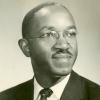The 'Peculiar Institution' Wasn't So Peculiar After All
Cobbloviate

Photo Credit: J.N. Nelson, New York Public Library, Wikimedia Commons
This little piece is a fuller version of an essay, which, in accordance with the Ol’ Bloviator’s quixotic crusade to better educate the Yankees on matters historical, was posted up yonder at TIME.COM.
Reflecting on recent calls for stripping the name of Robert E. Lee, a slave owner who went to war in slavery’s defense, from Washington & Lee University, historian Emory Thomas noted that the school’s other namesake, George Washington, was also a slaveholder, and raised the awkward possibility that one of the country’s most distinguished liberal arts institutions might be known one day simply as “&.”
Thomas spoke with tongue securely in cheek, but the scenario he posited seemed a logical, if absurd, progression of the current obsession with de-christening institutions, buildings, parks or thoroughfares named for someone with ties to slavery. However well-intentioned such efforts may be, recent explorations by several historians suggest how truly monumental the task of rooting out connections with such an indisputably powerful, intricately pervasive, and ultimately integral institution would be.
African slave labor had been introduced on the tobacco plantations of the seventeenth century Chesapeake, but slavery’s emergence as a truly dominant force in national and international commerce and finance awaited the arrival in 1793 of Eli Whitney’s fabulous cotton gin, which spurred the explosive spread of cotton-growing and slavery across the southern interior and into the new southwestern states of Alabama and Mississippi. The booming southwestern cotton frontier proved an irresistible magnet for both people, free and unfree, and financial investment. Some struggling Upper South planters opted to relocate with their slaves in tow. With slave prices rising meteorically in response to soaring demand, and stoked as well by a congressional ban on further importation after 1808, many others simply consigned their increasingly valuable human property to a massive stream of bound labor destined first for the lucrative slave markets of the Southwest.
Cotton accounted for nearly one-third of the value of U.S. exported merchandise by 1820, and closer to two-thirds by 1860, more than three-fourths of it going to Great Britain.
Maintaining this fibrous connection between southern slave plantations and the voracious looms of Lancashire required myriad supporting ventures in production, trade, services and financing on both sides of the Atlantic. With the American banking system still wracked with growing pains in the early 19th Century, English firms like Baring Brothers marketed high-yield bonds backed by the slaveholdings of planters in Louisiana and elsewhere, while profits extracted from the slave trade supplied vital capital for the nascent Barclays Bank. As the American financial system matured, a wide range of domestic banks got in on this act. Two of these, Citizens’ Bank and Canal Bank of Louisiana, which accepted roughly 13,000 slaves as collateral and came to own well over a thousand slaves outright, were cogs in the great financial wheel that became J. P. Morgan Chase. Likewise, Moses Taylor, director of the City Bank of New York, the forerunner of Citibank, managed the fruits of the tireless exertions of slaves on large sugar plantations and was also deeply involved in the illicit importation of slaves into Cuba.
Northern shippers also profited handsomely after 1808 in the brisk interstate transfer in slaves that saw some one million bondsmen transferred by sea as well as land from the upper to the lower south between 1810 and 1860. Thus it was not in New Orleans but in Providence that some of the state’s most prosperous and influential citizens gathered at what the local newspaper described as “a very numerous and respectable” meeting, on Nov. 2, 1835, to unanimously endorse several resolutions condemning the actions of recently formed anti-slavery societies in the free states, declaring “coercive measures for the abolition of slavery” a “violation of the sacred rights of property” and “dangerous to the existing friendship and of business between different sections of our country.” This proclamation was altogether fitting. Rhode Island had sent more than twice as many ships to Africa for slaves than all of the other colonies or states combined, many of them as part of the infamous Triangular Trade in New England rum, African slaves and southern or Caribbean molasses and sugar. Across the region, a sizable workforce was also employed in building the vessels requisite to these activities. Although slavery was said to be the “peculiar institution” of the South, so pervasive were Boston’s entanglements with it that one wonders whether when the Lowells spoke only to the Cabots, the subject of their common ties to the slave trade ever came up.
As for New York, surely there are few cities, North or South, where so many prominent physical fixtures are tied to slavery, even down to key sports venues like Madison Square Garden, Citi Field, and the Barclay Center. These disturbing reminders are actually less incongruous than they seem. Even though the international slave trade had been illegal for more than half a century, this illicit commerce was being conducted so brazenly in the city, the London Times dubbed New York “the greatest slave trading market in the world” in 1860.This appellation seemed to trouble the city’s Episcopalians less than their Anglican brethren across the water, however. More than once the convention of the Diocese of New York declined by an “overwhelming majority” even to discuss resolutions asking the Bishop and clergy of the diocese to speak out against a practice so blatantly contrary to “the teachings of the Church” and “the laws of God.”
Ironically, in an era when so much wealth was derived from pursuits directly related to slavery the two institutions seemingly most deserving of philanthropy were churches and colleges. Surely no institution of higher learning has confronted its historical indebtedness to slavery and the slave trade more forthrightly than Brown University, whose principal early benefactors included the Brown brothers, who, operating under the name of Nicholas Brown and Company raked in hefty profits from trading and transporting slaves. All told, at least thirty members of Brown’s early governing board at one time owned or captained slave ships. Meanwhile, Tench Francis, who wrote the insurance for some of the Brown Company’s slaving voyages, became one of the founding trustees of the University of Pennsylvania, whose ranks presented a virtual who’s who of Philadelphia’s high-profile slave traders. And so it goes, from Rutgers to Columbia to Yale and Harvard, all of which and others detailed in Craig Steven Wilder’s Ebony and Ivory, benefited significantly at some point from the largesse of men who owned or trafficked in human beings.
Although we might quibble about matters of degree, there is no escaping the critical role of slavery in facilitating our development as a nation. Historian Calvin Schermerhorn has it right when he calls enslaved Africans laboring in southern cotton fields “the strengths and sinews of a robust capitalist system.” By maximizing the output of labor-intensive cotton agriculture in order to keep pace with the demands of mechanized textile production abroad, slavery established a vital and timely reciprocity with the Industrial Revolution that would first stabilize and then position this country for its remarkably swift journey from the periphery to the core of the world economy. Lest they exaggerate what can be achieved by simply scouring the taint of slavery from the faces of a variety of American institutions and edifices, those who propose to do so would do well to heed the words of a former bondsman featured in the title of Edward Baptist’s recent book on slavery and American capitalism, for they are truly reacting to a story whose “half has never been told.”
More by James C. Cobb
-

-

When Historians Made History Themselves
Cobbloviate
-










comments